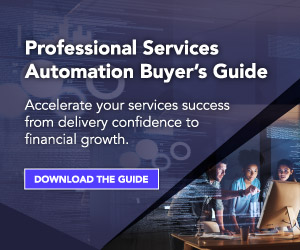
Organizations are always looking for new ways to reduce costs and improve efficiency, even during the best market conditions. When faced with economic pressure, there’s an even greater need for these companies to capitalize on opportunities that enable them to maximize revenue.
This is one of the reasons why an increasing number of organizations are diversifying their service offerings throughout the customer lifecycle.
And one area gaining momentum is the adoption of as-a-service models. An increasing number of professional services organizations are actively exploring this as an option for boosting incremental revenue.
In this blog post, you will learn more about:
- The connected-as-a-service model
- The subscription services model
- How connected-as-a-service helps maximize revenue
Discover how as-a-service offerings enable continuous service delivery and ensure consistent, predictable revenue streams.
Why Is Maximizing Revenue with Connected, as-a-Service Offerings Important?
Traditionally, professional services organizations only billed based on time and materials (T&M). But organizations that are transitioning away from T&M offerings to more connected, as-a-service offerings are able to build a more consistent cash flow and improve customer retention through ongoing engagement.
There are several key advantages of connected, as-a-service offerings, including:
- More stable, predictable, and recurring streams of income
- Easier scalability
- Access to valuable data insights
- Improved customer retention
These are only a few of the competitive advantages they offer to help companies thrive in a dynamic business environment.
There’s a strong correlation between customers who are engaging and using professional services and those who are likely to remain long-term customers.”
Paul Yaros, Chief Customer Officer at Planview
What are some other benefits of connected, as-a-service offerings?
In a recent webinar, Planview’s leading experts discussed this innovative approach to professional services. They explored how subscription services can elevate revenue and enhance customer engagement for professional services firms. We’ll touch on those advantages in this blog post, and you can explore them even further by watching the on-demand webinar.
But before we dive into the benefits, let’s first take a closer look at connected and subscription services.
What are connected services?
When we speak about connected services, we’re referring to a shift beyond the traditional services model – a shift to a model in which services are provided by a connected business unit operating as a strategic enabler for the organization. This starkly contrasts with how things were traditionally done, where a single business unit provides services.
Connected services establish a critical link in the organizational chain that joins customer and solution value. This is achieved by integrating and aligning systems, data, work, people, and customers.
What are subscription services?
Subscription services bundle together various service delivery elements throughout regular engagements and billing. As software has evolved from perpetual licensing to subscriptions, professional services follow the same trend.
Professional services organizations are increasingly interested in this model.
In a 2023 survey conducted by TSIA, more than 50% of companies responded as being “curious” or taking initial steps toward a subscription model for professional services.
With connected services and subscription services, providers can offer more flexibility and predictability in service and cost, as well as open a recurring revenue stream for the organization.
How Should PSA Platforms Support Different Ways of Engaging in Professional Services?
Some professional services companies may resist offering subscription services. That resistance may be because of system inefficiencies, such as the inability to bill in different ways beyond T&M or fixed fees. Others may be stuck in a cycle of reactive planning and inaccurate forecasting due to fragmented systems, data, and processes.
A professional services automation (PSA) platform can help simplify the transition to a subscription model and drive more value for your business and customers.
For example, Planview’s PSA solution helps professional services companies sell more services throughout the customer lifecycle. This is done by increasing speed across the lifecycle, predictability in capacity and utilization, and alignment with business partners on outcomes.
Companies can use this solution to:
- Better understand the pipeline of incoming work
- Balance resource supply and demand
- Allocate resources to client initiatives
- Accept and deliver on more customer engagements
Unlock the Full Capabilities of Your PSA Platform
“Subscription services are here to stay,” Yaros says. “As customers become more comfortable with services delivery in a subscription manner, that also becomes an easier path for commercial engagement.”
Transitioning to a subscription services model is a powerful way for professional services organizations to sell more services throughout the customer lifecycle.
Watch our on-demand webinar on maximizing revenue with connected, as-a-service offerings to learn more about how professional services can deliver incremental revenue with the offerings covered in this post.
You will gain a deeper understanding of the potential challenges of switching to a subscription service, and how your organization can overcome these challenges with the help of Planview’s PSA solution.




